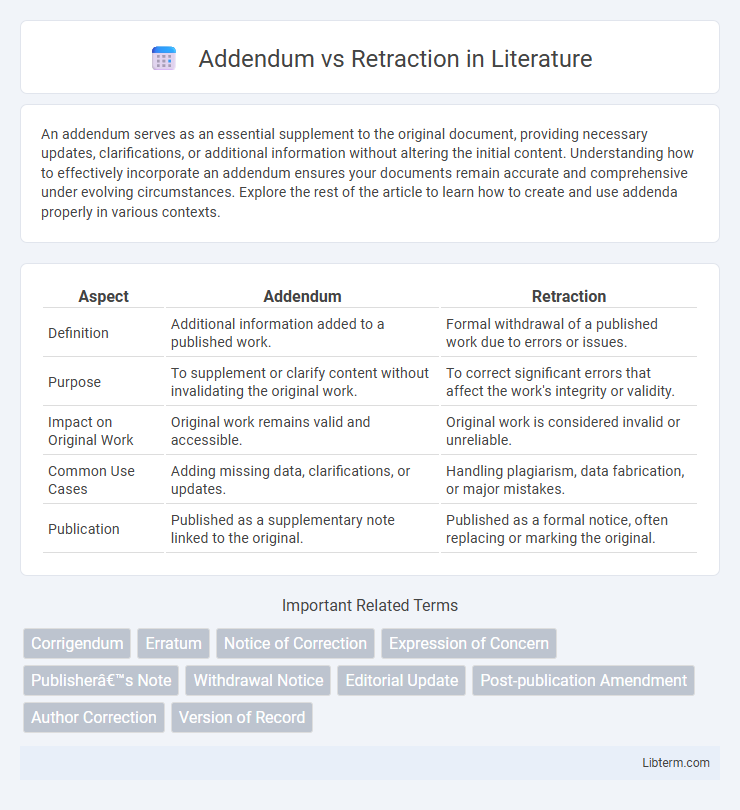An addendum serves as an essential supplement to the original document, providing necessary updates, clarifications, or additional information without altering the initial content. Understanding how to effectively incorporate an addendum ensures your documents remain accurate and comprehensive under evolving circumstances. Explore the rest of the article to learn how to create and use addenda properly in various contexts.
Table of Comparison
| Aspect | Addendum | Retraction |
|---|---|---|
| Definition | Additional information added to a published work. | Formal withdrawal of a published work due to errors or issues. |
| Purpose | To supplement or clarify content without invalidating the original work. | To correct significant errors that affect the work's integrity or validity. |
| Impact on Original Work | Original work remains valid and accessible. | Original work is considered invalid or unreliable. |
| Common Use Cases | Adding missing data, clarifications, or updates. | Handling plagiarism, data fabrication, or major mistakes. |
| Publication | Published as a supplementary note linked to the original. | Published as a formal notice, often replacing or marking the original. |
Understanding Addendum and Retraction: Key Definitions
An addendum is a document added to a published work to provide supplementary information or corrections without altering the original content, enhancing clarity and accuracy. A retraction involves withdrawing a publication due to significant errors or ethical issues, indicating that the findings are unreliable or invalid. Understanding these key definitions helps maintain integrity and trust in academic and professional communications.
Purpose of an Addendum in Scholarly Publishing
An addendum in scholarly publishing serves to provide additional information or clarifications that enhance the original research without altering its main conclusions. It addresses minor oversights, supplementary data, or updates that improve the article's accuracy and completeness. Unlike a retraction, which completely withdraws the publication due to errors or ethical issues, an addendum maintains the integrity of the original work while ensuring transparency and continued trust in the academic record.
When Is a Retraction Necessary?
A retraction is necessary when published research contains significant errors, fabricated data, plagiarism, or ethical violations that invalidate the study's findings. Unlike an addendum, which provides supplementary information or minor corrections without affecting the overall validity, a retraction removes the paper from the scientific record to maintain research integrity. Retractions safeguard the reliability of literature by clearly signaling studies that should no longer be cited or relied upon.
Addendum vs Retraction: Core Differences
An addendum is a supplementary addition to a published document that provides extra information or corrections without altering the original conclusions, while a retraction involves formally withdrawing a published work due to significant errors or misconduct that invalidate the findings. Addenda maintain the integrity of the initial publication by enhancing clarity, whereas retractions indicate fundamental flaws requiring removal from the scientific record. The core difference lies in the nature of the update: addenda add value, whereas retractions eliminate unreliable content.
Legal and Ethical Implications
Addendums in legal documents serve to clarify, update, or correct information without negating the original content, ensuring transparency and maintaining contractual integrity. Retractions, however, involve withdrawing statements or documents due to errors or falsehoods, which can lead to legal consequences such as breach of contract or fraud allegations. Ethically, addendums demonstrate good faith by providing accurate information, whereas retractions may indicate prior negligence or misconduct, impacting the credibility of the parties involved.
Impact on Author Reputation and Publication Integrity
Addenda enhance author reputation by demonstrating transparency and a commitment to accuracy, reinforcing trust in the publication process. Retractions can significantly damage an author's credibility due to errors or ethical issues, casting doubt on their work's validity. Both addenda and retractions play crucial roles in maintaining publication integrity by correcting the scientific record and upholding ethical standards.
Common Causes for Addenda and Retractions
Common causes for addenda in published articles include the need to correct minor errors, update data, or provide additional information that enhances the original content without altering the study's conclusions. Retractions typically arise from more serious issues such as research misconduct, data fabrication, plagiarism, or fundamental errors that invalidate the findings. Both addenda and retractions serve to maintain scientific integrity by ensuring the accuracy and reliability of the scholarly record.
Editorial and Peer Review Processes
Addendums are editorial tools used to update or clarify published research without altering the core findings, ensuring transparency in the peer review process. Retractions, by contrast, signify the withdrawal of a publication due to significant errors or misconduct, reflecting a failure in initial peer review verification or ethical breaches. Both mechanisms play critical roles in maintaining the integrity and reliability of scientific literature through rigorous editorial oversight.
Best Practices for Handling Addenda and Retractions
Best practices for handling addenda and retractions emphasize transparency and prompt communication to maintain research integrity. Addenda should clearly specify the additional information or corrections without altering the original findings, while retractions must provide a detailed explanation of errors or misconduct to prevent misinformation. Proper documentation and adherence to journal guidelines ensure accountability and preserve scientific credibility.
Case Studies: Notable Addenda and Retractions
Notable addenda often clarify or update original research findings without invalidating the study, such as the 2018 addendum in a groundbreaking cancer research paper that corrected dosage details but maintained overall conclusions. High-profile retractions, like the 2010 retraction of Andrew Wakefield's study linking vaccines to autism, highlight cases where falsified data caused widespread misinformation and public health concerns. These case studies emphasize the critical role of addenda and retractions in maintaining scientific integrity and trust.
Addendum Infographic

 libterm.com
libterm.com